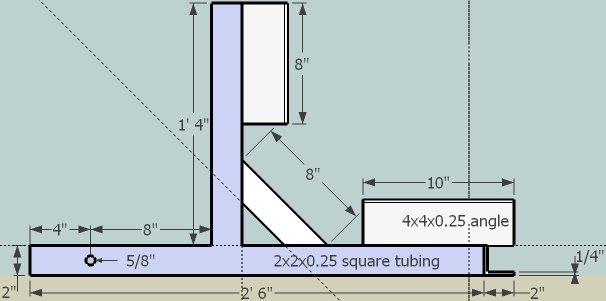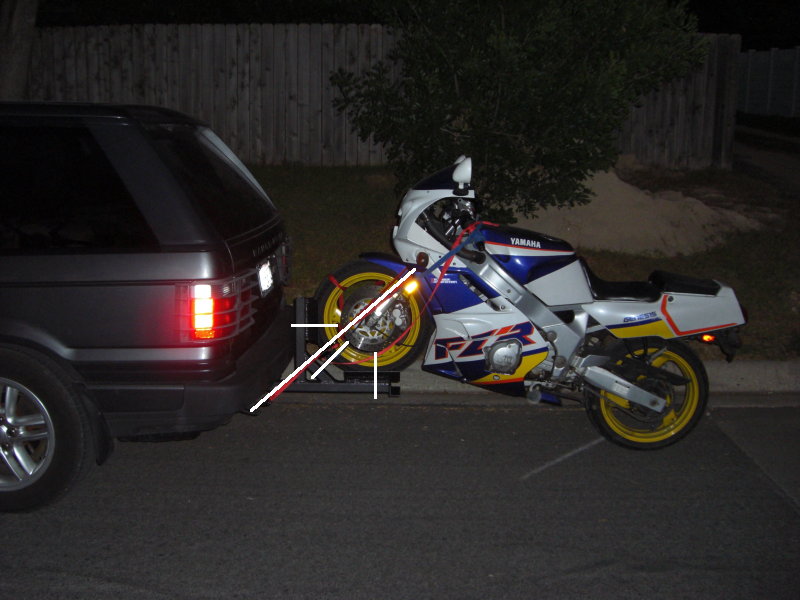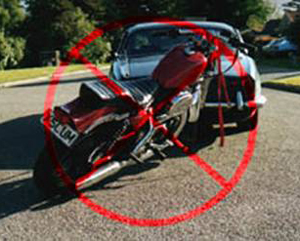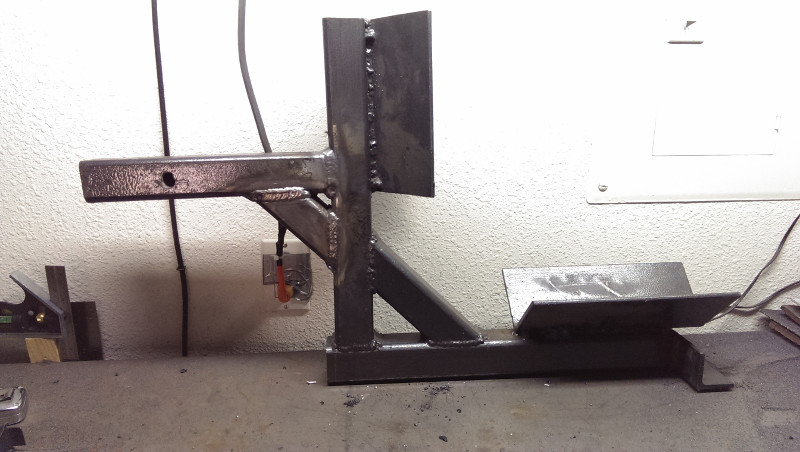Motorcycle Tow Bar
A recent rash of trailer rentals has left me craving a motorcycle-capable trailer, but our property will not accommodate one. Since our motorcycles and our friends' motorcycles are constant works in progress, it will be very handy to be able to tow a bike. Someone will need rescue eventually.
Necessary warning: welding, painting, driving, and towing are dangerous. Building and using your own towing equipment is very dangerous, so do not do it. I am not responsible for anything. If anything goes wrong, you have only yourself to blame.
Scouring the Internet turned up several receiver hitch mounted ways to tow a motorcycle. Several of the more expensive varieties incorporated trailer screw jacks and other moving parts. Other designs had complex curved shapes made of relatively thin steel to hold the wheel. The design I liked best was also the simplest: no moving parts, easy cuts, strong shapes. However, the production version of the design I found used thin steel and the parts holding the front wheel did not make enough wheel contact for my taste. I decided to improve on this design by beefing it up a bit and making sure its dimensions fit our vehicles. The most important dimension for us was the receiver pin to bumper clearance distance because our Rovers' receivers are tucked under the vehicle more than most. This receiver tow bar should be able to accommodate motorcycle front wheels 18.5" to over 30" overall diameter, which is 9.25" to 15" radius. The smallest wheel likely to fit is a 120/70R12 or 120/90R10 scooter tire and the largest stock wheel I could find was an 80/90R21 Sportster Custom tire, but that only has a 13.3" radius. The tow vehicle must have a class III 2" receiver or better. Obviously, the motorcycle must have a functional and secure front wheel, rear wheel, and steering.
I designed the tow bar using Google SketchUp. The model has layers for various parts, text, and dimensions. Here are two images from the CAD model. The first shows pretty much everything needed to duplicate the design. The second shows a different view with a 3'6" 2x6 ramp attached, but a 3' ramp may be needed for shorter wheelbase motorcycles. The motorcycle should be driven or pushed up the ramp. A tie-down strap should secure the front wheel to the 45 degree 2x2 tube that braces the vertical tube to the horizontal tube. Additional tie-down straps should connect the left and right sides of the triple trees or handle bars to solid points under the left and right sides of the bumper. These additional tie-down straps compress the front springs, help secure the wheel to the tow bar and vehicle, and keep the motorcycle from leaning in turns.


Aside from paint, clamps, a welder, a motorcycle, and various tie-down straps, here are the raw materials required:
- 2"x2" steel square tubing with 1/4" wall: 5'
- 4"x4" steel angle 1/4" thick: 18"
- 2"x2" steel angle 1/4" thick: 6"
I spent about $100 on materials including tax. I cut all of the pieces with a cutoff wheel on my 4" angle grinder. I prepared every weld surface with a grinding wheel and stainless steel wire wheel, MIG welded with pure argon gas (not ideal, but works) at 25cfh, and used solid core 0.035" ER70S-6 wire. I ran out of gas at the end after making reinforcement MIG passes where the 4" angle meets the 2" tubing, so I filled in some arc welds for additional thickness using 3/32" A6011 electrodes. I cleaned the whole thing with Zep Orange Citrus cleaner/degreaser, rinsed with warm water, wiped dry, and air dried for one day. After cleanup and drying, I painted with two coats of Rustoleum Hammered black.
Here is the finished product (sorry for the night shot):

However, I now suggest the use of three tie-down straps to secure the front wheel to the tow bar where the white lines are: horizontal at the front, 45 degrees at the brace, and vertical at the bottom. Straps are cheap and they make me feel better. I suggest using a ratchet tie-down from each side of the sprung fork triple trees to each side of the bumper so the fork springs compress 25%-50%. This spring action is necessary to keep tension on the straps and to prevent strap overload when the tow vehicle's vertical angle changes relative to the motorcycle's. It is imperative that the front wheel not lean side-to-side or slide in the V holders. Additional straps securing the bottom of the front wheel to each side of the bumper and the receiver's safety chain mounts will help lock the wheel into the tow bar and prevent twist. Loading the bike is a two-person operation unless you are prepared with accessible straps already connected to the tow vehicle. The tow bar does not hold the motorcycle upright by itself.
Even when the front tire and forks are well secured, the rest of the bike leans enough to make me nervous when going around 90 degree right hand turns, but no foot pegs or turn signals scraped the ground during my testing. The reason for this is the bike's rake angle and the fact that the front wheel is elevated off of the ground. The effect is accentuated because the pivot point is well behind the tow vehicle's rear wheels. The pivot point's angle is not 90 degrees to the ground like a trailer and a trailer ball, so the motorcycle body actually leans quite a bit in sharp turns, but in the opposite direction of the turn. Newer and more plentiful tie-downs along with some safety chains would make me feel better. The leaning effect is exaggerated because the front fairing on my FZR is actually connected to the body and not the forks, so it looks very strange in sharp turns from the rear-view mirror. I've seen plenty of sportbike stoppies and hard braking, so I'm not particularly worried about this amount of lean angle damaging the steering head bearings. I didn't snap any photos of my bikes leaning in sharp turns, but I borrowed this one from Fatz, who makes a pivoting tow bar that eliminates the leaning problem. Another pivoting tow bar is the TOW-STER.

All of that being said, it will work just fine if we are in a jam. I do not think I would have a problem going a long distance with this if I had newer tie-downs and I stopped to check the rigging periodically.
After a few years of dust on this thing, I decided to update it a bit because I need to use it again. I put a 10" drop on it to get the front wheel a lot closer to the ground. In addition to being much easier to load and unload, lowering the front wheel brings the steering angle closer to 90 degrees to the ground and therefore reduces the amount of lean in sharp turns. Now the loaded height of the front wheel is more like 8" off the ground instead of 18". Here's a photo of the modified tow bar:

If I were building this again, I would make a pivoting design similar to the Fatz or the TOW-STER.




